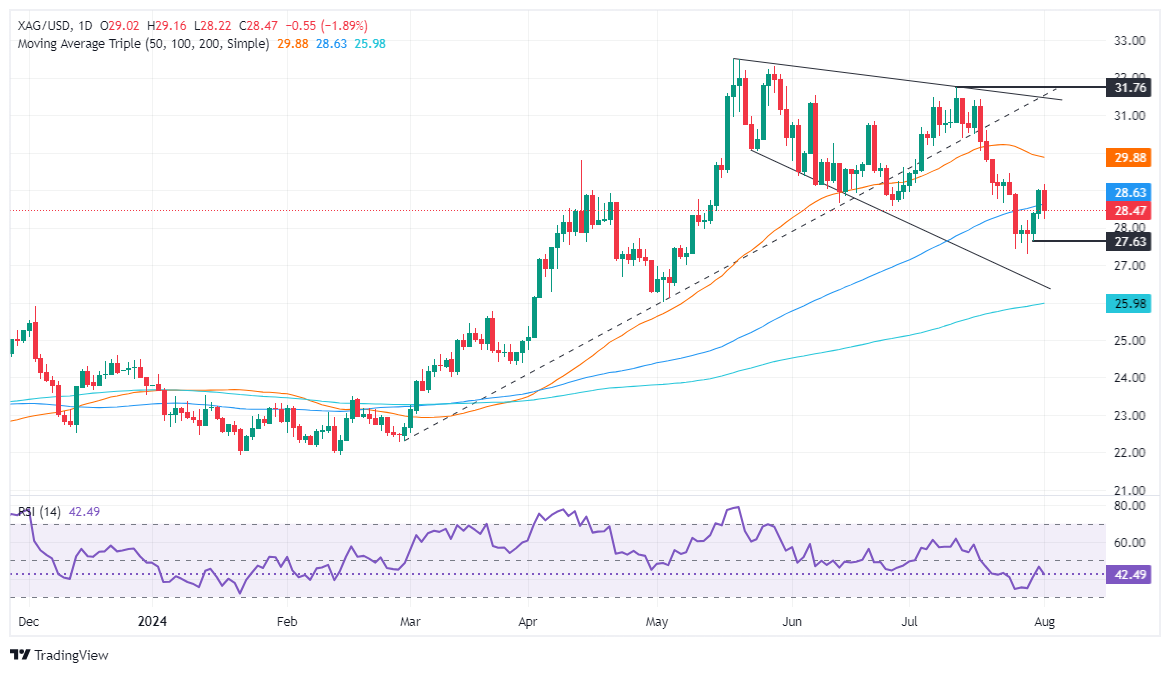Silver Price Analysis: XAG/USD descends over 2% amid recession fears and risk aversion
- Silver price loses 2% and falls below 100-DMA at $28.61.
- Failure to close above $29.00 intensifies bearish momentum; next support at $28.00 and July 29 low of $27.31.
- Resistance seen at 50-DMA ($29.86) and psychological level of $30.00 if upward movement resumes.
Silver's price made a U-turn on Thursday and dropped from weekly highs of $29.15 amid growing tensions between Hamas, Hezbollah, and Israel and recessionary woes surrounding the US economy. The XAG/USD trades at $28.37, down over 2%.
XAG/USD Price Analysis: Technical outlook
The precious metal shifted neutrally biased, as prices fell below the 100-day moving average (DMA) at $28.61, signaling bulls' weakness. They failed to achieve a daily close above $29.00, exacerbating a dip to a two-day low of $28.22.
If XAG/USD drops below $28.00, the grey metal will challenge the latest cycle low at $27.31, the July 29 floor level. On further weakness, sellers eye the 200-DMA at $25.98.
On the other hand, if XAG/USD rises past $29.00, the next ceiling level will be the 50-DMA at $29.86, followed by the $30.00 psychological level.
XAG/USD Price Action – Daily Chart

Silver FAQs
Silver is a precious metal highly traded among investors. It has been historically used as a store of value and a medium of exchange. Although less popular than Gold, traders may turn to Silver to diversify their investment portfolio, for its intrinsic value or as a potential hedge during high-inflation periods. Investors can buy physical Silver, in coins or in bars, or trade it through vehicles such as Exchange Traded Funds, which track its price on international markets.
Silver prices can move due to a wide range of factors. Geopolitical instability or fears of a deep recession can make Silver price escalate due to its safe-haven status, although to a lesser extent than Gold's. As a yieldless asset, Silver tends to rise with lower interest rates. Its moves also depend on how the US Dollar (USD) behaves as the asset is priced in dollars (XAG/USD). A strong Dollar tends to keep the price of Silver at bay, whereas a weaker Dollar is likely to propel prices up. Other factors such as investment demand, mining supply – Silver is much more abundant than Gold – and recycling rates can also affect prices.
Silver is widely used in industry, particularly in sectors such as electronics or solar energy, as it has one of the highest electric conductivity of all metals – more than Copper and Gold. A surge in demand can increase prices, while a decline tends to lower them. Dynamics in the US, Chinese and Indian economies can also contribute to price swings: for the US and particularly China, their big industrial sectors use Silver in various processes; in India, consumers’ demand for the precious metal for jewellery also plays a key role in setting prices.
Silver prices tend to follow Gold's moves. When Gold prices rise, Silver typically follows suit, as their status as safe-haven assets is similar. The Gold/Silver ratio, which shows the number of ounces of Silver needed to equal the value of one ounce of Gold, may help to determine the relative valuation between both metals. Some investors may consider a high ratio as an indicator that Silver is undervalued, or Gold is overvalued. On the contrary, a low ratio might suggest that Gold is undervalued relative to Silver.